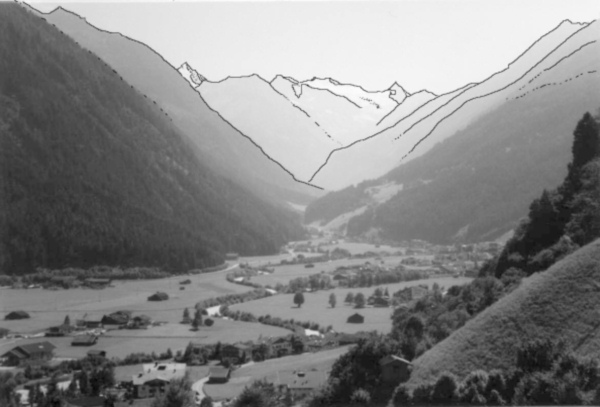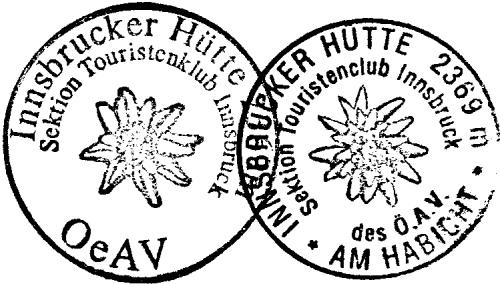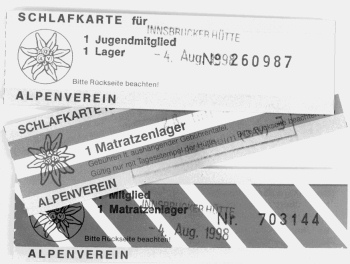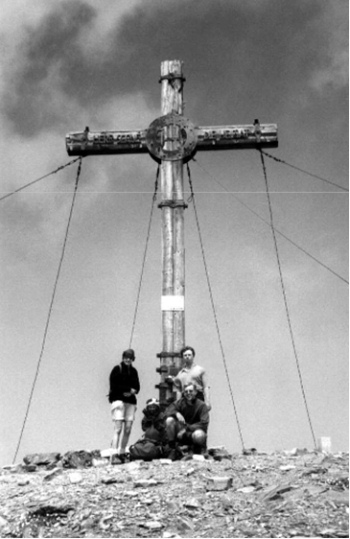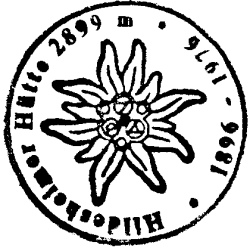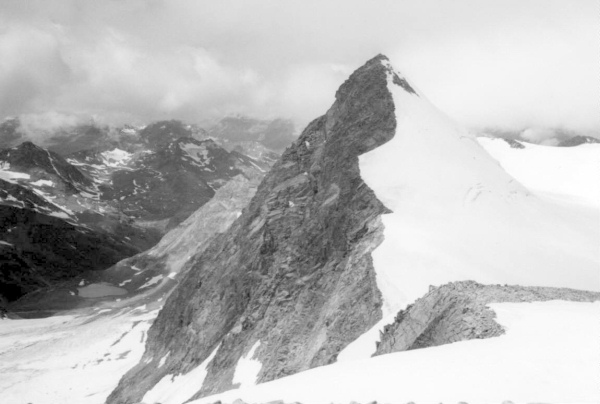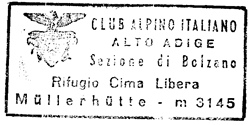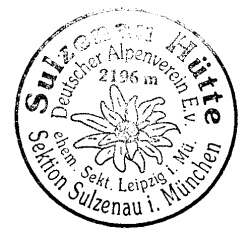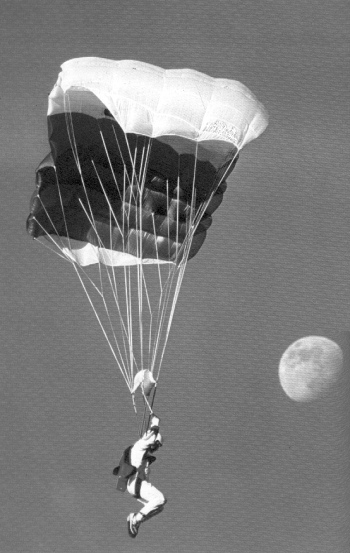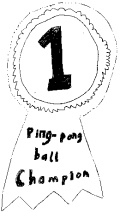Alpine Meet Neustift, Stubaital 25 July – 8 August 1998
Among the peaks climbed were:
Zuckerhütl 3507m
Wilder Pfaff 3456m
Wilder Frieger 3418m
Habicht 3277m
Schaufelspitze 3332m
Serles 2717m
Hoher Bergsrall 2611m
Elferspitze 2505m
Attendance:
Denis Armstrong
Joan Armstrong
Denis Barker
Anne Edmonds
Alan Fletcher
Mike Godden
Marcia Godden
Alan Linford
Angie Linford
Alister Renton
Kevin Renton
Sheena Renton
Alexander Renton
Ellen Renton
Joanne Moorhouse
Euan Seaton
David Smith
Elspeth Smith
Michael Smith
Helen Smith
Richard Smith
Fiona Smith
The Stubaital by Alan Linford
There are many ¼ plate slides of Austria in the archives suggesting that members frequently visited the area. But a quick search of the journals would indicate that this was the first Club meet there and from the enthusiasm shown by those attending this would not be the last Austrian Alps meet.
Austria is easily accessible-providing you plan early enough, Alan Fletcher arrived one day early and had to leave two days after the rest left due to flights being fully booked. The meet leader arrived one day late having missed his flight connection and left two days early to fly to Indonesia, such are the demands of modern life. Four members arrived with caravans indicating a more leisurely approach to life, providing a haven for campers in the frequent thunderstorms and cool beers in blistering heat. Expertise was improved in card games, new and old, the Smith family taking a liking to pontoon. A rewarding experience for children and adults, ask yourself, when could Richard and Fiona be quietly poker faced?
Elferspitze 2505m
a limestone peak with some fixed ropes and hoops
The Elferspitze towers above the camp site, the sky line reminiscent of the spires of the Picos. A gondela adjacent to the camp site hoisted two groups (on the first day and therefore justified) from 1000m to 1812m. Excellent value with reductions for holding a camp card and extra reductions for senior citizens the down side being that Richard aged 12 years was rated as an adult.
We found it to be a popular mountain with well marked paths and good views all around, giving what we all appreciate, an opportunity to orientate the mountains and valleys with the map There are more paths than were shown on the map. It is a mountain with plenty of opportunity to do your own thing with walkers, climbers and scramblers approaching the summit from all directions, creating a queue for the last 15ft roped climb to the very small and exposed top. The path wanders through rock falls and buttresses, snow patches here and there, to a welcome seat at the col named Zwolfernieder. A near vertical zig zag path (not marked on my map) tempted the Smith family to walk back to Neustift via Autenalm, the Linfords preferring the Panoramaweg giving excellent views of the Pinnistal valley and the difficult looking rock peaks above it. Two ‘Yorkshire Tea’ brews were needed to take it all in.
Schaufelspitze 3332m
The end of the Stubaital valley is dominated by 4 large car parks servicing the Stubaier Gletscherbahn which unfortunately gives easy access to the high glaciers. Live television monitors show visitors the conditions at the Eisgrat restaurant at 2850m. Useful as it saved Angie and I money and time as on our first visit the cloud level was down to 2500ft raining, 4°C and windy. Plan A to climb the Schaufelspitze was abandoned for the less ambitious Daunkoph, 2879m, so we took the bahn half way to the Dresdner hut at 2303 m and set off. With the cloud level coming down and remembering the resolution made in Norway never to walk in the mist again, we exercised plan B to walk to the Mutterberg See at 2483m. On the Wilder Grube we were caught in a violent thunderstorm with torrential rain. We exercised plan X and walked down a construction track to the valley. The track served a new construction site at Ganisgarten, a place to be avoided, but the road had bridged the larger streams and spare drainage gullies used to bridge the smaller streams which saved us having to ford. We had sticks and waterproofs but others caught out had neither and made a very slow descent.
The second attempt saw us early on the cable car to be met at the Eisgrat with a roped off corridor leading up to the Bildstockjoch the glacier commandeered by monster piste making machine smashing the glacier up to mush for skiers and snowboarders. It was 11°C! We walked up outside the roped in area. The bahn is being extended to the Bildstockjoch creating a large construction site, dust everywhere, excavations having destroyed the start to the Wildspitze 3341m and the Schaufelspitze. However a nice scramble up with the summit to ourselves and looking over to the Zuckerhütl 3507m raised our hats to the lads climbing there. Beating a retreat we climbed part way up the Wildspitze, gained access to the glacier and ignoring cries from the mangle men, made our way down the glacier, now running with water, to the cable car.
In 1999 it will be possible to use cable cars to reach the Hildesheimer hut without touching the glacier. What a shame.
In complete contrast, a trip up to the Fernerstrube glacier by the Sulzenauhütte and the Blaue Lacke was an absolute delight. Not a soul above the lake apart from two climbers descending from the Mullerhütte, who said conditions were not good on the ridge as it had not frozen overnight, wet feet for our lads up there (lads include David Smith!). There is a splendid alp, Sulzenaualm at the mid point of the walk, the hut run by an elderly couple, where the sevice, friendleness and ambiance were reminiscent of mountain huts 40 years ago. Carvings abound on chairs, tables, walls, beams and posts in dining room, gate posts, to obtain the hut stamp it was necessary to remove the tongue of a gargoyle! Not an easy place to leave.
Habicht, 3277m by David Smith
A handsome mountain which looks larger than it really is because of its separation from other larger peaks. Jeff Williams – Stubai Alps and South Tyrol
There comes a time in life when the great glaciers and the highest peaks have less of a pull than in earlier years. The Habicht seemed the sort of mountain that provided all the pleasures of the sport but none of the pressures. I opted for the chairlift to Elfer with the two younger members, the remainder of the group crammed into a four wheel drive vehicle from Neder. The weather looked promising, the descent along the Panoramaweg into Pinnistal, though very pleasant, meant that valuable 500m in height was lost. The path varied through woods and meadows heading down to a small hamlet of Karalm where we joined the main route from Neder to the Innsbrucker Hütte.
Here the height was gradually regained along the Alfairgrube where we met up again with the rest of the party resting in the sunshine. We reached the Innsbrucker Hütte at 2369m early, and though intending making the ascent of the Habicht straight away, decided that as the glacier snow might be soggy we would to climb the nearby Pinnisjoch. This turned out to be an unwise decision as the loose limestone construction of the mountain was decidedly unreliable and in my view dangerous. Furthermore we later discovered that the glacier was virtually none existent and we would have had an easy ascent of the Habicht in good weather.
‘The Boys’ decided that they would bivvi and spent some time looking for the ideal site between the boulders before returning to the hut for an evening meal. I was quite happy to make use of the comforts of the hut, though why we were packed into one room we weren’t aware until the army arrived in force. As we settled down to sleep a storm rapidly built up, we were all conscious of our two friends outside fighting the elements. During a nocturnal perambulation I discovered two bodies on the floor narrowly missing by inches putting my foot in a mouth.
One particularly good thing about Austria is that there is no need for 4 a.m. starts, consequently we didn’t get up until 6.30 a.m. We didn’t bother about a breakfast other than a drink before setting off for the hill. The mist was down but the route finding was very straight forward, much of the more exposed sections are well protected with wire ropes fitted with aluminium ‘eggs’ to help progress. We had the mountain to ourselves which is always a plus. The Editor’s twelve year old son moved like a seasoned veteran, at no time did he have a problem, clearly the Club has a future in the Alps.
Jeff William’s guide gives a very clear description of the route, ascent weat and south-west before climbing quite steeply north-west over fixed ropes, sharp change of direction south-west up a rocky ridge alongside the Habichtferner and traverse the glacier. Where was it? surely it wasn’t the little patch of snow in front of us, But yes, it was. The Alps aren’t what they used to be! We soon reached the summit, saw nothing and after a bite to eat set off down. The mountain has a dreadful history of accidents of those who take short cuts, we didn’t and quickly reached the hut.
The weather was now improving and it was a speedy descent into the valley. We decided to try out the four wheel vehicle and were packed, two deep in places, into the small car, not a comfortable journey but different. Three of us had intended using the second day traversing over to the Bremer Hütte along route 124 and over to Ranalt in the Unterbergtal, which I feel is, the best way to ‘do’ the Austrian Alps. Perhaps next time.
Serles, 2717m by Michael Smith
Months in advance of the meet, Ken Aldred, who has lead many parties through the Stubai mountains, was kind enough not only to supply a couple of guidebooks to the area but several pages of advisory notes. Included in these was the description of the best road approach to Serles which was from the far side as we were looking at it from the campsite.
Somehow in the usual chaos of deciding where to go and who was coming along we failed to take note of this point. This may sound careless to those unfamiliar with the Club’s larger camping meets but picture the scene… M meets S in the washroom and formulates an outline plan for objective ‘A’ provided that R can be persuaded to make up the number and E will drop everyone off at the chairlift. Meanwhile R, returning from the supermarket or cashpoint, bumps into E who has heard from the guides that the weather is closing in late in the day and fancies trying objective ‘B’. Over a meal the previous night two others have hatched a plan to ascend ‘C’ and are seeking others to join them. By the time these six protagonists have wandered round the several tents and vans trying to drum up support everyone is in a quandary. Suddenly, no doubt as predicted by chaos theory, a pattern emerges and almost everyone – except the two who, being fully provisioned and not in need of cash, have already set off – heads off for ‘D’ the one place that has the advantage of not favouring anyone’s previous plans.
Such was the prelude to two overfull cars disgorging their passengers at the foot of the single-seater chairlift from Mieders up into the thick clouds surrounding Koppeneck. The ride brought two delights: the shrieks of surprise as each one of us was swept off our feet by the fast-moving narrow seat (indeed it took some a while to pluck up the courage to plant their feet on the yellow marks and wait) and shafts of sunlight slicing through the misty Obergullenwald as we neared the top of the cloudbase.
The level walk through the forest to the healing pool by the Maria Waldrast shrine was only a few kilometres and brought us to the roadhead we would have driven to had we taken notice of Ken. This oversight and the 5pm closure of our chairlift back into the valley meant we spent the day clock-watching and hurrying along short-legged Fiona.
After an initial rise the path slackens around 2000m, crosses landslip scars, traverses through dwarf conifers then enters the steep, narrow limestone valley up to the Serlesjoch. A single spring, or quelle, lies to one side of the path and provided a welcome drink.
From the windy joch, as the cloud enveloped us and the odd shower hurried us along, it was a 350m sharp pull up over rock bands and scree to the top. Wearing shorts this was not a place to loiter and the first party was descending before the tail-enders reached the cross. Gaps in the cloud revealed the campsite below (provided you were brave enough to stand by the edge in the fiercly gusting wind) and the realisation that we had spiralled round the mountain a full 360° during the ascent.
Two o’clock and just three hours to cover several miles and 1100m down to the chairlift meant that an introduction to scree running was called for. It went down well (in both senses) and we were a relaxed and reunited party of ten who descended strung out along the line of chairs down with fifteen minutes to spare.
The Higher Peaks by Alister Renton
The last time I visited Austria was about seven years ago with my parents. We stayed in a village called Mutters, one of Innsbruck’s commuter communities. I remember large mountains and pleasant valleys. It was with these memories I set off to Neustift!
I arrived at the campsite late on Saturday night after a rather interesting flight and a very busy week at work. I had found time to read the guidebook during the flight and I had marked the most desirable routes that would be ideal for all members on the meet. The obvious route would have to be the Zuckerhütl (3505m) – the highest peak in the area.
I made my thoughts known to all and before long we had embarked on a three day expedition to visit this mountain.
We set off up the valley in two cars carrying all the gear required. David Smith entertained our car with an interesting mathematical problem that he apparently solved in ten minutes! (It’s at the end) We decided to stay and eat in style at the two huts so we only had small rucksacks 😉
At the top of the Stubai valley is a large car park to hold all the winter skiers’ cars; Elspeth dropped us off and we purchased tickets for the cable car. Now I know that you are not supposed to use cable cars but it was a real bargain – especially for those that got a discount!
We arrived at the top cable station in high spirits ready for the walk to the first hut. At the top of the cableway is a summer ski area with the hut path alongside – we navigated this and the industrial equipment in transit to the building site at the top. They are extending the cable car ready for the winter skiers.
After a little while we arrived at the hut and checked in. We sat down and planned the next two days on the hill. Michael Smith spent about five minutes working on David’s puzzle before finding out the correct answer.
We all went to bed early in a bid to get a wink of sleep. Two years ago I vowed not to stay in any more huts and there I was lying in a noisy hut!
Morning soon came and we all dashed down for our breakfast, boots on and we were off to look at the Zuckerhütl. We were the first team away from the hut. The route proceeded round the edge of the moraine before reaching the side of the glacier.
We put on our crampons here before starting the standard alpine slog up to the first col of the day. This was the first trip high I had been on since Easter and I felt fine, humm, something must have been wrong.
We arrived at the col in good spirits and had a bite to eat. We still had not seen anybody else on the hill and that was concerning me a little as the guidebook said it is always a busy peak.
The cloud was swirling around and the summit ridge could be seen now and then. It did not look that far to the summit but the path took an indirect approach to allow easy access to the summit ridge.
We had decided to return via another hut, the Müllerhütte, and as such we would have to descend the Zuckerhütl by the same route. We left our rucksacks in a nice neat pile and set off for the summit. There was a very impressive cornice to one side, which made me a little nervous. The final pull to the summit included an interesting section of front pointing on nice crisp solid ice.
We all arrived at the summit safely and filled in the summit book with our names. We stayed on the summit for a while just enjoying the Alps.
The route down followed the ascent but we found the correct path this time! It made the descent much easier – true YRC style! We were soon to be reunited with our rucksacks and more and more people could be seen on the paths approaching the summit. With the Zuckerhütl complete all that we had to do was nip over another mountain and descend to the hut.
We started off, roped in two teams as there looked to be a number of crevasses en-route, to the based of the rock ridge we had to ascend.
No major mishaps occurred and we removed our crampons and ropes for the last time. The route up the Wilder Pfaff (3458m) was just a nice slog. It took about thirty minutes before we arrived at the summit. We had superb views of the Austrian Alps as well as views to the Dolomites. As you might have guessed we sat and enjoyed the views. The Müllerhütte could be clearly seen from the summit at the bottom of a rock ridge. The climbing was great and before long we made it onto the snowfield in front of the hut. We spent the rest of the day playing and practicing our techniques on a nice snow hollow that the sun had created.
The hut was undergoing major repairs to the stairwell and toilets and everyone was sitting outside keeping out of the way. Fine sawdust drifted in the wind despite the workers efforts to keep all waste bagged to be helicoptered down. We live in green times – once it would have been despatched down the nearest crevasse. A wind turbine and solar cells provided power for the hut.
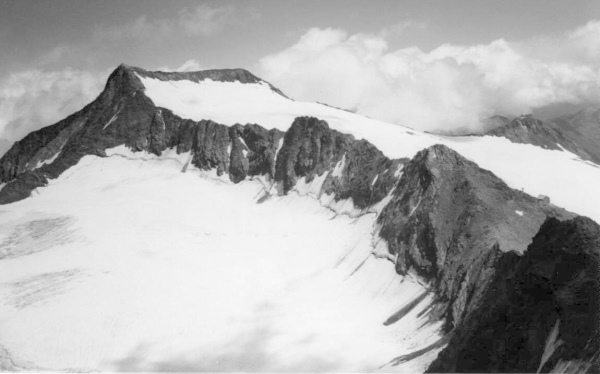
(from the Mullerhütte, seen on the right, the right end of the summit ridge was gained before traversing left to the true summit)
We were shown to a dormitory room which we had to ourselves – it would have been impossible to fit anyone else in anyway. Due to the refurbishments though lined the room had no bunks or fittings and we took it in turns to move about and eventually settle to a late afternoon nap.
Though the hut was actually in Italy and we only had Austrian Shillings with us the guardian did not seem to mind, she just entered it in her calculator and came out with a figure that was a little expensive.
The full works at the Müllerhütte looked a little pricey so we opted for something a little different, ordering individual dishes – but we had to wait until all the main parties had been served before they would take our order. So at about 7.30 we sat down and filled up ready for the following day.
Meanwhile there was much hammering, drilling and carrying to and fro of building materials accompanied by an all pervading stench of the drains as increasingly desperate attempts were made to get at least one toilet working before everyone settled for the night. They did it but only after consulting the instruction manual for the vacuum flushing system.
I slept very well, I have no idea why, but I did! The morning was clear and we were again the first team off onto the hill. We had to traverse the Pfaffenschneide before we could descend back to the valley.
Again as two ropes we weaved our way up the snowfield to join the rock ridge and on to the summit. We left our rucksacks at a small border customs hut that must have been used during the war to defend the Austrian territory.
We were the first team to the summit. The cloud was starting to roll in from Italy, spilling over the cols along the border ridge, so we made a hasty retreat to our rucksacks before embarking on the long walk down to the valley.
The walk out was very pleasant with lovely green valleys and pastures. The odd snow patch to cross added to excitement, Alan descend them in a most elegant way!
After a couple of hours we arrived at the Sulzenauhütte, we invested in a drink here and sat a while and reflected on the trip. I had a quick nap.
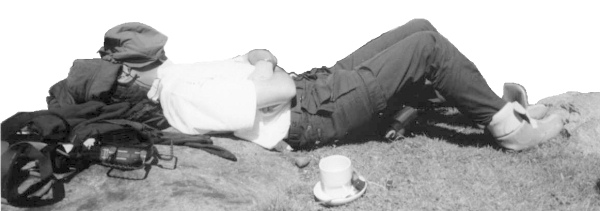
We had completed three excellent peaks in two days and had a great time. The team was comprised of:
Alan Fletcher
Alister Renton
Euan Seaton
David Smith
Michael Smith
Richard Smith
The last name on the list is the important one. Yep, that is Michael’s son, he did the whole trip and all the peaks that we did – he is only twelve years old. A name to look out for in the future.
All in all we had a great trip, good weather, excellent company and three peaks.
David’s Puzzle
| TEA EAT + ATE |
| BUNS |
Each letter in this sum represents a single different digit. What value does each letter represent?
Airborne in the Alps by David Smith
From the first time I saw paragliding from the mountain tops in Chamonix I dreamed of being airborne but never thought I ever would. Tony Smythe tried to encourage me, Jon Riley had a go, so why not me. Too old perhaps? Would I break a leg? Could I justify the cost?
I wandered round to the landing field near Neustift to witness a landing and to discover that it did not look too hazardous. I now don’t think I would have overcome my reticence had it not been for encouragement from my wife. Had she been checking the insurance policies I wondered? I decided to ‘go for it’ and booked a flight on a tandem canopy. As luck would have it I had picked a perfect day. My co-pilot was a Tyrolean-Italian by the name Oliver, a pleasant fellow. We took the chair lift up to Elfer and Oliver carefully laid out the canopy, the connecting ropes looked more like string to me, but they were numerous enough to give confidence.
My connection to the device was a comfortable sort of back rest which once airborne became a sort of seat. The take off was a mere three strides downhill, then we soared into the air. It was a wonderful dreamlike experience floating in air, we picked up the thermals, (not the sort one might wear close to the skin), sometime they buffeted us, other times picking us up gently and changing the direction. The valley and the mountains could be seen as the birds see them. Quite incredible. Oliver took photographs for me during the flight, I would have wasted the experience had I used the camera myself. The view changed with ever twist and turn, my co-pilot made sure that I got the full works.
Slowly we neared the landing field; there was a small white spot about twelve inches in diameter, surely we could not land on it; but we did. I don’t think my landing was copy book stuff but I was safe and sound having had an exciting fifteen minutes. A worthwhile and enjoyable experience to be sure and only £4 per minute!
Meanwhile, Down at 1000 metres… by Anne Edmonds
Attending the Stubaital meet with Denis Barker was my second Alpine holiday: I could not avoid comparisons with my first, the Lauterbrunnen meet in 1994 – in every respect Stubaital won hands down.
Neustift im Stubaital (993m) is half way along a wide smiling valley dotted with beautiful villages each dominated by a painted church tower and set in flowery meadows; the naturally wooded sides of the valley, topped by peaks, rise steeply from the Reutx, a comparatively unthreatening torrent (which runs off the Mutterberg glacier at the head of the valley); at Milders (1026m), the next village up the Ruetz, the Oberberg valley joins, with its own mini – torrent and glacier but minus villages. This topography provided ample opportunities for a sixty five year old who can cope with distance walking but avoids the scramble.
Three types of walks are available:-
From Schaller (1080m) right down to Fulpmes (937m) we found macadamised paths passing by immaculately kept Alpine houses (their traditionally – painted windows smothered with geraniums and petunias) which take walkers through hay meadows reminding me of the sweet smelling fields of my British childhood – before industrial farming killed off everything but ragwort and knapweed. We watched the hay harvest, the steeper slopes cut by scythe, and breathed in the pungent scents of drying blossoms. Denis and I decided that when we got too old for hill walking we shall take a package flight from Britain with half pension in Neustift – Marcia and Mike Godden gave us the idea of this happy compromise.
Secondly, from Fulpmes to the Mutterberg a network of footpaths runs through the woods and up to the mountain huts and provides delightful but undemanding walks up to about 14000m. One day we took the bus to the Mutterbergalm (1721m) – (a large hotel set in a very nasty car park) and walked through the Alpine woods and meadows past the spectacular Sulzaubach and Langenbach waterfalls, through the hamlets of Fanalt and Falbeson, meeting hardly a soul, down to Volderau (1129m) surely the source of the wanderers’ song chorus – folderee, Volderau …
Another day we climbed up to Kartnall (1284m) on an alp above Neustift and down into the Oberberg, then up again along a path serving a succession of valley farms and back through Milders woods and the path to Neustift. Another walk took us down the valley to Medraz then up through the Stations of the Cross Maria Waldrast path which goes up to the huts for Serles and Sonnenstein. We are happy to reach the inevitable café at 1364m (misleading called the Sonnenstein – Denis Armstrong was most impressed when I told him where I had been. I did confess). Another day we went to the aims at Inner Pfurtschell (1297m)and Vergör (1266m) above Fulpmes, which could have taken us to a hut at 1634m but didn’t. (Note on ‘alms’; this seems to mean ‘café’ and every walk leads to several. Some members of our party – who shall be nameless – turned their days into apfelstreudel crawls from alm to alm).
The third type of walk is based on the seilbahn from Neustift which we used twice (lifts from other villages would give access to equally scenic walks). We took a one way ticket to Agrar (1794m) and walked to the Elferhütte (2004m) (a sophisticated flood-lit café hotel despite its name), then along the Panoramaweg with awful (sic) views of the Hammerspitze (2634m) and Kirchdachspitze (2840m) to Zwolfernieder at 2335m under the Elferkofl (2505m) where I terrified myself watching climbers climbing down the fixed ladders. Then down (and down and down) a steep path to Autenalm (1658m). This was the most stunning scenic walk we did, going through a landscape as lovely as the alpine and rock gardens at the Edinburgh Botanicals. Hard walking though and we were relived to zigzag along a forest road from the Autenalm and Neustift watching our tent grow bigger with every turn of the way. Later in the holiday we took a Hin ünd Zurück on the seilbahn. Against Denis’ inclination and because I wanted to walk the Panoramaweg in the opposite direction, we went from Agrar down to Pinnisalm (1560m), a beautiful woodland walk, but then I met my come-uppance – literally – in a long drag up a dusty jeep track to the Karalm (1747m) and then a steep circular climb up to the Panoramaweg at 2150m. It was a very hot day and I was exhausted when we met the Armstrongs sensibly coming in the opposite direction. This was a walk I enjoyed only in retrospect.
As well as the walks (which avoid the almost vertical climb out of the valley from Lauterbrunnen) other aspects of the holiday were also much more enjoyable.
We found Austria, unlike Switzerland, very cheap – supermarket prices, even in a tourist village, much the same as in central Edinburgh while restaurants and cafés are cheaper. The seilbahn is very reasonable – especially for OAP’s at £4 single, £5.50 return – and the bus fares compared well with Edinburgh and the Borders. And the Austrian schilling was (very properly) twenty to the pound.
I liked the Austrian attitude to visitors – clearly tourism is an economic necessity (even though farming is still vital) but they didn’t make this obvious by Swiss-style money grabbing. There were few British visitors (visually proven by the litter free paths), most being very polite Austrian or German holidaymakers (with Gruss Gott a dozen times a kilometre). The service in cafés, shops, public transport etc. was unfailing courteous yet unobsequious. Most people spoke some English but were civil enough to understand my four words of German (which swelled to around four hundred over the fortnight).
Neustift itself is delightful. The opulently painted 18th Century church interior suggests a long established prosperity reflected in the immaculate houses and splendid community centre where four energetic young men in Tyrolean costumes played for dancing (no charge) every Monday evening. A magnificent swimming pool (with a spectacular flume mercifully separated from the main pool and a cat flap out to an open air section) entertained me on our one day of uninterrupted rain. Helen Smith, fount of all knowledge about village activities and campsite facilities, found a separate open air pool for Fiona while Richard was on his first climb with Michael. She also sent the children on a four hour pony trap excursion with boating lake and barbecue costing only £2.50 each – move the decimal point to estimate what the Swiss would charge for that . There was also an open air concert hall with a brass band performing every Friday – unfortunately not well enough to be musical and not badly enough to be funny – but it too was free; Denis tried to pay but found he had bought a drink of local schnapps from an unhygienic communal glass. The town was full of cafés and restaurants – the whole party ate together on the last night at a very good and reasonably priced restaurant sussed out by Alan Fletcher and Evan Seaton and called most incongruously for Neustift (where good taste and traditionalism was the norm) Harry’s Bar.
The camp site was excellent – right next door to the supermarket and with clean, warm, insect free ablutions. No queues for showers because no coach parties of American students à la Lauterbrunnen. There was one coach with a Czech registration full of strange men in outsize babygrows who sat inside smoking and drinking all day but not washing their hair.
There was also good washing up and laundry facilities although the proximity of a midden to the clothes line left us smelling like cowherds.
One and all enjoyed a table tennis tournament in the games room organised by the Smith children and won (fairly of course) by Papa Smith.
Across from the camp site was the paraglider landing field which Denis watched wistfully but where David Smith took the plunge and won his wings. The church was close by and told us the time four times an hour – the bells did stop at 11.45 p.m. but woke us at seven with a very special peal. The weather was, as Angie Linford put it, “iffy” for the first nine days – just like Scotland and very good for walking. When it turned to blazing sun I longed for some cloud cover.
To conclude – a really delightful holiday and Stubaital strongly recommended for non-climbing members.
An apology – sorry for all the adjectives but Neustift really is that kind of place. And I’m trying to temper my enthusiasm for all things Austrian by reminding myself that the neo-Nazis there poll a higher vote than anywhere else in Europe. Also Denis points out that the strong pound would make even Switzerland cheaper this summer.
PS – Note for travellers – Denis and I drove back via the Oberammergau route – not Fussen; we recommend it. Also Ulm and Speyer are good stopover towns – easy of access, good and cheap hotels, charming pedestrianised old quarters.
PPS – Etymological note – seilbahn means literally “cable way” so when in Yorkshire the rain seils down it is coming down like cables.
Saying of the meet – Euan Seaton, “…looking forward to getting home and having a proper beer without a Z in the name.”
Marmots were observed on the Pinnisjoch, we met a harvest mouse on the Sultzenau path and had a close encounter with Ibex on Habicht.
The Armstrongs found the best Apfelstreudel at Barenbad in the Obergatal and whilst sampling the delicacy were rewarded with a good sighting of three young eagles.
